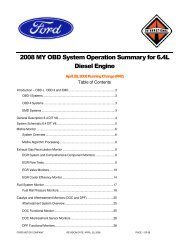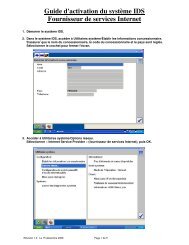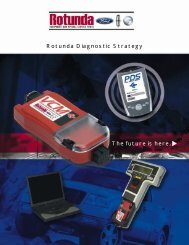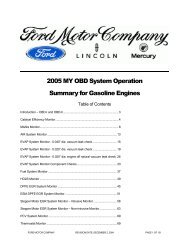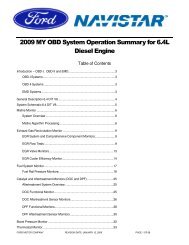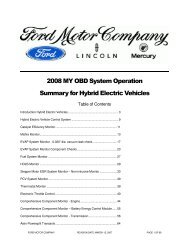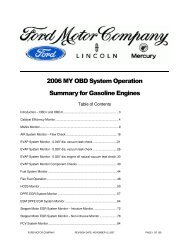OBD Operation Summary for 6.7L Diesel - MotorCraftService.com
OBD Operation Summary for 6.7L Diesel - MotorCraftService.com
OBD Operation Summary for 6.7L Diesel - MotorCraftService.com
- No tags were found...
You also want an ePaper? Increase the reach of your titles
YUMPU automatically turns print PDFs into web optimized ePapers that Google loves.
Exhaust Gas Temperature Sensor Rationality TestEach EGT Sensor is checked continuously <strong>for</strong> proper circuit continuity and out of range high values. In addition, arationality test is per<strong>for</strong>med once every drive cycle, after a soak of 6 hours or greater. The rationality test consistsof two <strong>com</strong>ponents, the first being a <strong>com</strong>parison against modeled values, and the second being a key-on 5-waytemperature sensor <strong>com</strong>parison. At key-on, a temperature sample is taken of each of the following sensors:Ambient Air (AAT), Exhaust Gas Temperature (EGT11), Exhaust Gas Temperature (EGT12), Exhaust GasTemperature (EGT13), and Exhaust Gas Temperature (EGT14). Once the engine starts and a cold start has beenconfirmed, the model <strong>com</strong>parison tests begin. The model <strong>com</strong>parison tests ensure that each sensor correlates withan expected modeled value, and a fault is set if the difference is significant and persistent. When the model<strong>com</strong>parison tests are <strong>com</strong>plete, the temperature samples from key-on are <strong>com</strong>pared against each other, and thetemperature differences are <strong>com</strong>pared against a threshold. One sensor must fail key-on plausibility with four othersensors to set a fault. If two sensors fail plausibility with three other sensors a general fault is set (P117B). Therationality tests rely on entry conditions that include engine operation time, minimum modeled temperature,minimum engine coolant, and minimum engine torque. Once the entry conditions have been met, the model<strong>com</strong>parisons continue <strong>for</strong> several minutes to ensure a robust detection. The modeled value <strong>for</strong> EGT11 is based onModeled Turbo Temperatures. The modeled value <strong>for</strong> EGT12 is based on EGT11. The modeled value <strong>for</strong> EGT13is based on EGT12. The modeled value <strong>for</strong> EGT14 is based on EGT13.Exhaust Gas Temperature (EGT) Sensor Circuit Check:DTCs P0545 – Exhaust Gas Temperature Circuit Low (Sensor 1)P0546 – Exhaust Gas Temperature Sensor Circuit High (Sensor 1)P2478 – Exhaust Gas Temperature Out Of Range (Sensor 1)P2032 – Exhaust Gas Temperature Circuit Low (Sensor 2)P2033 – Exhaust Gas Temperature Sensor Circuit High (Sensor 2)P2479 – Exhaust Gas Temperature Out Of Range (Sensor 2)P242C – Exhaust Gas Temperature Circuit Low (Sensor 3)P242D – Exhaust Gas Temperature Sensor Circuit High (Sensor 3)P247A – Exhaust Gas Temperature Out Of Range (Sensor 3)P2470 – Exhaust Gas Temperature Circuit Low (Sensor 4)P2471 – Exhaust Gas Temperature Sensor Circuit High (Sensor 4)P247B – Exhaust Gas Temperature Out Of Range (Sensor 4)Monitor ExecutionContinuousMonitor SequenceNoneSensors OKNot applicableTypical Monitoring Duration 2 sec.Typical Exhaust Gas Temperature Sensor Circuit Check Entry Conditions:Entry Condition Minimum MaximumBattery Voltage 8v 15vKey OnFORD MOTOR COMPANY REVISION DATE: FEBRUARY 9, 2012 09.01.00.02-PAGE 108 OF 157



